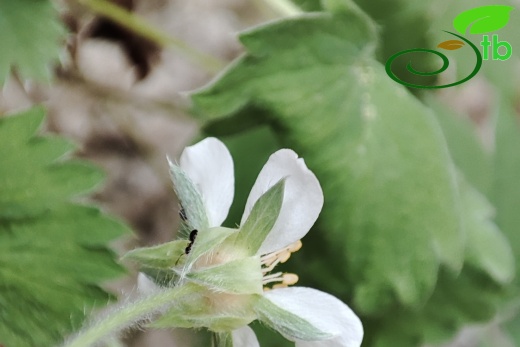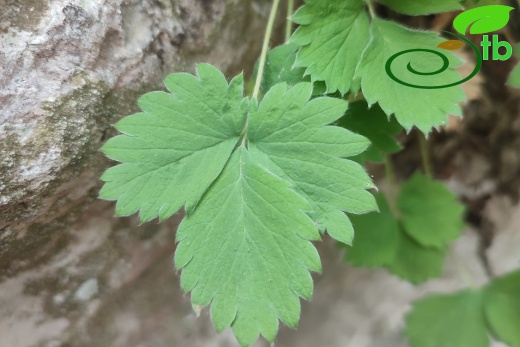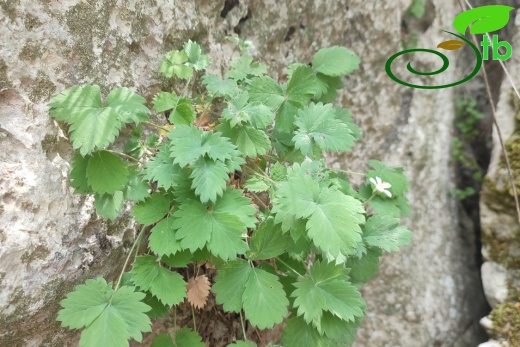Potentilla ulrichii
Potentilla ulrichii
Yastık parmakotu
Densely tufted to cushion-forming perennial with brownish woody caudex covered with scarious, persistent stipules and occasionally petiolar remains. Flowering stems decumbent-ascending or pendent, 10-35 cm, rather slender , often somewhat flexuous, shorter to considerably longer than basal leaves, olive yellow, sparsely or densely clothed with short eglandular and glandular pubescence interspersed with many 1-2 mm long, soft, white, patent, eglandular hairs. Leaves chiefly in rosettes, normally distinctly bicoloured, surface thinly pilose, glabrescent, deep green to greyish green or olive yellow , lower face densely silvery sericeous with appressed long hairs, paler , with very small scattered yellowish sessile glands on both faces. Basal leaves long-petiolate, trifoliolate; leaflets obovate, cuneate at base, lateral leaflets 2.5-5 × 2-2.5 cm, terminal leaflet 3.5-6 × 2.5-3.5 cm; apex of leaflets blunt or shortly acute, margins deeply and coarsely incised-serrate to 2/3 or nearly down to base, with 8-9 sharp, ± triangular teeth on either side; teeth 3-6 mm, larger teeth sometimes with an additional lateral tooth; petiole 5-10 cm long , slender , canaliculate above, thinly to densely spreading-villous with a mixture of soft, 0.5-2 mm long eglandular and much smaller, subsessile to shortly stalked glandular hairs; stipules broadly lanceolate-acuminate to narrowly ovate, c. 6-14 × 3-5 mm, light brown to brownish orange, long pilose along margins and on midrib, adnate basally to the lower part of the petiole. Cauline leaves similar but smaller and with green stipules, diminishing upwards, shortly petiolate or subsessile, leaflets with fewer teeth, the uppermost sometimes 1-foliolate and functioning as a bract of a partial inflorescence. Inflorescence a rather dense, ± corymbose cyme, with flexuously ascending branches, many-flowered 15-30 flowers); in all parts densely to moderately villous with the same type of indumentum as on stems and petioles. Bracts foliaceous, usually less than 12 × 4 mm and variously lobed or toothed, uppermost c. 6-7 × 2 mm. Pedicels 12-20 mm, very slender . Flowers relatively small. Epicalyx segments 5, narrowly ovate-lanceolate, acute and sometimes denticulate, about 4-5 × 1-1.5 mm. Calyx shallowly cup-shaped, densely sericeous-villous, 6-7 mm diam., moderately accrescent in fruit; divided into 5 sepals of nearly the same shape, size and indumentum as the epicalyx segments. Petals white, obovate, distinctly clawed, longer than the sepals, c. 4.5-6 × 2.5-3 mm, apex rounded . Stamens c. 30; filaments 2.5-4 mm long, pilose in lower 5/6, more loosely so in upper 1/2, anthers pale yellowish-brown, oblong, c. 0.6-0.8 × 0.3 mm. Receptacle conical, up to 2 mm in fruit, densely white-pilose. Ovary pale, glabrous, minute, c. 0.6-0.8 mm long; style subapical, glabrous, filiform , at least 4 × as long as carpel, caducous, stigma truncate. Nutlets ivory, kidney-shaped, distinctly compressed, c. 1.6-1.8 × 0.9 mm, glabrous, surface conspicuously ornamented with anastomosing ridges and thus appearing scrobiculate-reticulate, margin narrowly winged.
Endemic.







